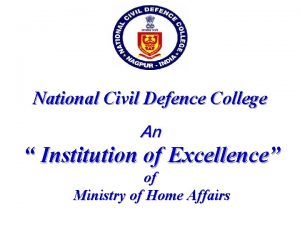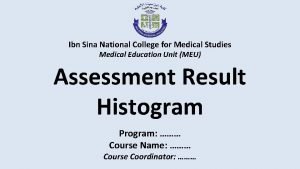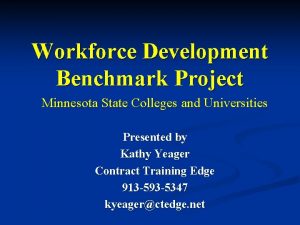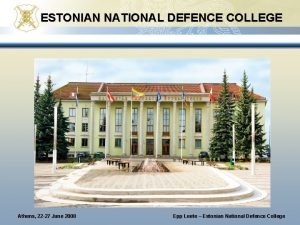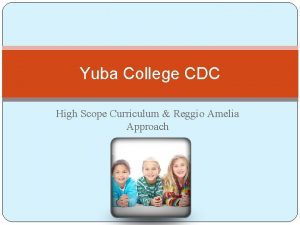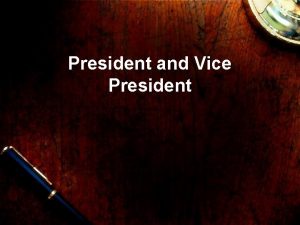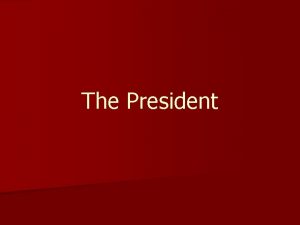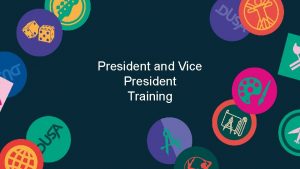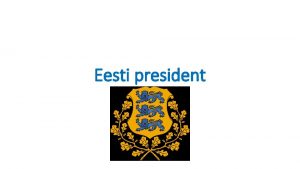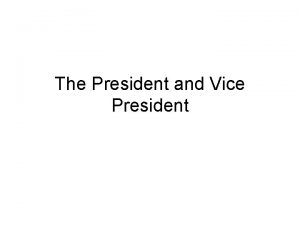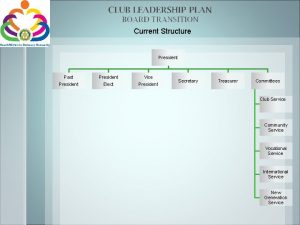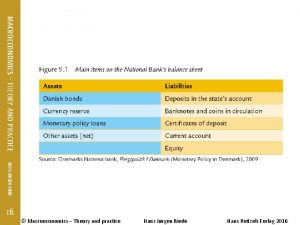Introduction Hans Meeder President National Center for College




















































































- Slides: 84

Introduction Hans Meeder President, National Center for College and Career Transitions November 2015

Our Vision EVERY LEARNER WITH A DREAM AND A PLAN, EVERY COMMUNITY WITH A CAPABLE, READY WORKFORCE.

About NC 3 T - Leadership NC 3 T is led by Hans Meeder, former Deputy Assistant Secretary at the U. S. Department of Education, and a respected national leader conducting research and providing technical assistance on high school redesign, career and technical education, and workforce development.

About NC 3 T – What we do The National Center for College and Career Transitions works to connect schools, postsecondary institutions, and employers in order to introduce students to the array of options available to them, and to help them prepare for the types of opportunities for which they are best suited. NC 3 T provides planning, coaching, technical assistance and tools to help communitybased leadership teams plan and implement their college-career pathway systems.

Pathways System Design Services • • • Technical assistance starting at the visioning stage and continuing through implementation. Coalition-building to bring multiple stakeholder groups to the table and develop mutually beneficial components within the pathway system. Onsite and virtual coaching to address clients’ unique needs and challenges in an efficient and timely manner. Proven resources and tools that ensure all components of a pathway system are addressed. Customized professional development and keynote speaking so that all stakeholders receive a consistent message and continue learning. Meeting facilitation to safeguard from unproductive sessions.

PATHWAYS INNOVATION NETWORKS

Resources Available Now

Coming Soon! Discover all the essential knowledge that will empower you to lead a Pathways initiative in your school, your college, and your community. • Developing a pathway program of study, incorporating the 12 essential components • How to build a pathways system with K -12, postsecondary, workforce and employer partners • Branding and communications • Leading change • Career exploration with impact • Research synthesis on pathways • Understanding workforce & postsecondary trends

Initial Thoughts about Need, Vision and Action Hans Meeder President, National Center for College and Career Transitions November 2015

The Need for a Change • What are the visible challenges that point to the need for stronger Academic and Career Planning? • What are the underlying challenges that need to be addressed to develop better Academic and Career Planning? • Summary Statement of Need for Change. We need stronger academic and career planning because. . . (note: address both visible and underlying challenges).

Example • Visible challenges – • My car is emitting thick black smoke from the exhaust. • Underlying challenges • There’s oil leaking into the pistons. • Summary Statement of Need for Change. • My engine is burning oil, which is bad for my car and bad for the environment. It’s also illegal and I could have the car impounded. I need to fix this.

Actions & Benefits ü What will we continue to do as we implement our academic and career planning system? ü What action steps will we take to implement our academic and career planning system? ü What will be the benefits for a strong academic and career planning system?

EXAMPLE: Actions & Benefits ü Continue to do – • I’m going to continue putting gasoline in my car so I can drive it, and continue to pay my insurance premium. ü Action steps – • I’m taking the car to the mechanic to get an estimate on the repair. I’ll probably get it fixed, and I will have the car regularly maintained from now on. ü Benefits – • My car will be better running, more dependable, and better for environment

SUMMARY VISION & ACTION Summary statement of vision (what the future will be) and actions (what will be done). • Through stronger academic and career planning. . . Our students will. . • Our parents and families will. . . • Our schools will. . . • Our employers will. . . To achieve this outcome, we will. . . (note: list action steps)

Leading Yourself and Leading Change Hans Meeder President, National Center for College and Career Transitions November 2015

FOR CONSIDERATION • • • What are the positive aspects and potential pay-offs to my leadership role? What are the biggest challenges and questions relating to structure, roles and responsibilities? What skills, knowledge, and resources will we need for our new staffing structure, roles and responsibilities?

Session Agenda – Part I Leading Yourself • Developing your Emotional Intelligence Leading Others • The 8 Elements of Leading Change

Leadership is the lifting People's Vision to a higher sight, the raising of their performance to a higher standard, the building of their personality beyond its normal limitations. --- Peter Drucker

Leadership Bookshelf What Makes a Leader? (Goleman) Leading Change (Kotter) Good to Great (Collins) Switch (Chip and Dan Heath) Adaptive/Situational Leadership (Heifitz, Laurie)

Leadership Foundations What is Leadership? Leadership is not a Position. It’s a Disposition for Action, Foresight, and Excellence. Who is a Leader? A leader is anyone that is leading within his or her circle of influence. How do I develop Leadership? I develop leadership through focused learning, combined with practical application.

Leadership & Management • What is the difference between Leadership and Management? • • Leadership: Deciding where to go. Management: Making sure you get there. • Where is management most valuable? • Where is Leadership most valuable? • Are you more inclined toward Leadership or Management?

Leadership AND Management “All highly successful transformation efforts combine good leadership with good management. Transformation is not a process involving leadership alone; good management is also essential. A balance of the two is required. “

Limitation of Management Perspective Managers tend to think in terms of their immediate subordinates and boss, not the broader constituencies that need to buy into a vision. They tend to be most comfortable with routine factual communication, not future-oriented strategizing and dreaming. Of course, they can learn.

The Five Leadership Capacities Strengthening your personal leadership core Managing for continuous improvement Leading to the future Understanding Past and Present Envisioning the future

Strengthening Your Personal Leadership Core Understanding CTE Strengthening your personal leadership core Managing for continuous improvement Leading to the future Past and Present Envisioning the future

1. Your Personal Leadership Core

Emotional Intelligence Framework • • • Self-Awareness Self-Regulation Internal Motivation Empathy Social Skills

Self. Awareness Definition Recognize and understand your moods, emotions, and drives Hallmarks Self confidence Realistic self assessment Self-deprecating humor

Definition Hallmarks control or redirect Trustwor Selfdisruptive thiness/integrity Regulation impulses/moods Comfort with The propensity to ambiguity suspend judgment – Openness to think before acting change

Definition Motivation Passion to work for reasons other than money or status alone pursue goals with energy and persistence Hallmarks Strong drive to achieve Optimism, even facing failure Organizational commitment

Definition Empathy Understand the Hallmarks Expertise in emotional make-up building/retaining of others talent Treating people Cross-cultural according to their sensitivity emotional Service to reactions clients/customers

Social Skills Definition Managing relationships and building networks Find common ground and build rapport Hallmarks Effectiveness in leading change Persuasiveness Building and leading teams

Self-Reflection re: Personal Core Five minutes to begin the Personal Core (Emotional Intelligence) Self-Analysis. Identify ONE practical Action step to talk within three days of returning home.

Strengthening your personal leadership core Managing for continuous improvement Leading to the future Leading to the Understanding CTE Past and Present future Envisioning the future

Road-blocks to Sustained Change? • • • Political and leadership transitions, sweeping out old reforms. “Random Acts of Improvement” vs. continuous improvement approach. Lack of processes to document and lock-in reforms. Little support and/or understanding of the reform strategy No cohesive vision and action among educators, leaders, community members

5. Leading to the Future The Essentials of Leading Change … and Sustaining Reform

8 -Stage Process Leading Change 1. 2. 3. 4. 5. 6. 7. Establishing A Sense of Urgency Creating the Guiding Coalition Developing a Vision and Strategy Communicating the Change Vision Empowering Broad-Based Action Generating Short-Term Wins Consolidating Gains and Producing More Change 8. Anchoring New Approaches In The Culture

1. Create Urgency For change to happen, it helps if the whole organization really wants it. Develop a sense of urgency around the need for change.

1. Create Urgency What you can do: Identify potential threats Develop future scenarios Examine opportunities Start honest discussions Get people talking and thinking. • Request support from outside stakeholders • • •

2. Create a Powerful Coalition • There needs to be a leadership coalition to convince people that change is necessary • It needs strong leadership and visible support from key people • People on the group should have credibility and power • The group works as a team

2. Create a Powerful Coalition What you can do: • Identify the true leaders and key stakeholders • Ask for an emotional commitment Work on team building • Ensure that you have a good mix

Avoid these types at all cost s Two types of individuals should be avoided at all costs for the guiding coalition. • Egos that fill up a room • People who create mistrust that kills teamwork

3. Create a Vision for Change Vision refers to a picture of the future with some implicit or explicit commentary on why people should strive to create that future.

3. Create a Vision for Change What you can do: • Determine key values • Develop a short summary of the future • Create a strategy for action • Describe the vision in five minutes or less • Practice your "vision speech" often

The Power of Vision A good vision acknowledges that sacrifices will be necessary but makes it clear that these sacrifices will yield particular benefits and personal satisfactions that are far superior to those available today–or tomorrow–without attempting to change.

4. Communicate the Vision • Using every vehicle possible to constantly communicate the new vision and strategies • Having the guiding coalition role model the behavior expected of employees A BOLD VISION and WORKABLE STRATEGY are almost pointless without effective COMMUNICATIONS.

4. Communicate the Vision What you can do: • Talk often about your change vision • Address peoples' concerns and anxieties, openly and honestly • Apply your vision to all aspects of operations – from training to performance reviews • Tie everything back to the vision • Lead by example A BOLD VISION and WORKABLE STRATEGY are almost pointless without effective COMMUNICATIONS.

5. Remove Obstacles • Getting rid of obstacles • Changing systems or structures that undermine the change vision • Encouraging risk taking and nontraditional ideas, activities, and actions

5. Remove Obstacles What you can do: • Identify, or hire, change leaders • Align organizational structure to vision • Recognize and reward people Identify and help resistors • Quickly remove barriers (human or otherwise

“Those of us who are doing work on leadership and change frequently don’t appreciate sufficiently the sources of resistance. We frequently fail to have enough respect for the pain of these adjustments and changes. “ Conversation with Ronald Heifetz, Harvard Kennedy School of Government June 23 rd, 1999, Claus Otto Scharm

6. Create Short-Term Wins • Planning for visible improvements in performance, or “wins” • Creating those wins • Visibly recognizing and rewarding people who made the wins possible

6. Create Short-Term Wins What you can do: • Sure-fire projects that you can implement • Choose reasonably affordable early projects • Carefully set reachable performance targets • Reward the people who help you meet the targets

7. Build on the Change • Danger: Celebrating early victory can undermine momentum toward long-term goals • After short-term wins is the time to reinvigorating the process with new projects, themes and change agents

7. Build on the Change What you can do: • After every win, analyze what went right, and what needs improving • Set goals to continue building on the momentum you've achieved • Learn about continuous improvement • Keep ideas fresh

8. Anchor Change i n the Culture • Culture is the last thing to change; it follows demonstrated change and become natural • Make the change core to your organization • The values behind your vision must be demonstrated through the day-to-day work of the organization

Culture, Norms, Values Culture= norms of behavior and shared values among a group of people. Norms of behavior = common or pervasive ways of acting Shared values = important concerns and goals

8. Anchor Change i n the Culture What you can do: • Talk about progress • Tell success stories • Include the change ideals and values when hiring and training new staff • Publicly recognize key change agents • Begin succession planning for key change leaders asap

Break

Open space to think…discuss • A thought that occurred to me during the break was… • A question I still have is…

Strategies for Business and Community Involvement Hans Meeder President, National Center for College and Career Transitions November 2015

Session Agenda – Part 2 • Why Business-Education Partnership Matters • Key Strategies for Business and Community Involvement

Research: Benefit of Employer Engagement

Student benefits of employer engagement 1. Making learning more enjoyable and interesting 2. Increasing motivation to do well at school 3. Doing better in exams 4. Going into better paying jobs 5. Becoming more employable, getting access to better opportunities 6. Making better career decisions 7. Increasing aspirations Source: “What is to be gained through partnership? Exploring the value of education-employer relationships. Education and Employers Task Force, October 2010, Ed. Coms

Impact of employers on student motivation I understand better why it is important to do well at school. • • Strongly agree, 50% Agree, 40% Disagree, 7% Strongly disagree, 2% I am more prepared to work hard in lessons and my coursework. • Strongly agree, 42% • Agree, 47% • Disagree, 9% • Strongly disagree, 2% Source: Views of young people after work experience, IEBE survey of 15, 025 young people, 2008.

Employer-student connections lead to wage premiums The more employer contacts children recalled that they had while in school, the more they are likely to earn when in full-time employment as young adults. In fact, those who recalled four or more school-mediated employer contacts earned an average of 18% more than those who could not recall any. EET believes that the wage premium results more from better access to business information and social network development than to the development of technical or employability skills. Source: Journal of Education and Work, March 2013 http: //www. educationandemployers. org/research/taskforce-publications/wage-premiums/

What Employers Really Want… The requirements of the workforce are changing

What employers really want… Top skills for workers with high school diploma Top skills for workers with 2 -year degrees Professionalism/Work Ethic (80. 3%) Teamwork/ Collaboration (74. 7%) Oral Communications (70. 3%) Ethics/Social Responsibility (63. 4%) Reading Comprehension (62. 5%) Professionalism/ Work Ethic (83. 4%) Teamwork/ Collaboration (82. 7%) Oral Communications (82. 0%) Critical Thinking/ Problem Solving (72. 7%) Reading Comprehension (71. 6%) “Are They Really Ready to Work? ” Top skills for workers with four year degrees • Oral Communications (95. 4%) • Teamwork/ Collaboration (94. 4%) • Professionalism/ Work Ethic (93. 8%) • Written Communications (93. 1%) • Critical Thinking/ Problem Solving (92. 1%)

What’s your approach to creating partnerships?

What do partners want? How partnerships usually happen: ID Need > Build Program > Find Partners How does this model limit your success?

What do partners want? Problem 1: Not a Partnership If you set the goals and program structure, it’s not a partnership – it’s a sponsorship How are coalitions involved in K 12 partnerships? Source: Coalition Leaders Speak Out on Education, De. Havilland Associates, 2007

What do partners want? Partnership Selection Criteria Willingness to collaborate Interest in measurable outcomes Commitment to the project Needs of the student body Existing relationship with coalition Accessibility to location Source: Coalition Leaders Speak Out on Education, De. Havilland Associates, 2007 84. 7% 67. 6% 64. 0% 48. 6% 33. 3% 21. 6%

What do partners want? Problem 2: Tunnel Vision If you focus on a limited set of priorities, those who could help in other areas are shut out

What do partners want? The New Model: Find Partners > ID Need > Build Program Note: Needs are joint needs, including the needs of both education and business partners

What do business partners want? Return on Investment (ROI) Business is a game of limited resources: investments must generate an optimal return Not just for business decisions any more; “strategic philanthropy”

Part 1. Business Involvement Strategies

5 Strategies for Business & Community Involvement 1. Help Students Build Career Understanding 2. Facilitate Classroom Presentations Or Lead Small Group Discussions 3. Assist Students with Career and/or Leadership Projects 4. Offer Experiences Outside of School 5. Support Program Improvement And Advancement

Help Students Build Career Understanding • Host a table at a career or industry fair • Offer a work-site tour • Grant a career interview • Offer resume writing and mock job interviews support • Invite students to join you at a work event • Other?

Facilitate Classroom Presentations Or Lead Small Group Discussions • • • Talk to students about your career or industry sector Talk to students about a specific technical skill or use of equipment Talk to students about general workplace skills and culture Talk to students about career exploration and career navigation Other?

Assist Students with Career and/or Leadership Projects • Act as an expert judge • Act as a project coach • Assist teachers with career -related units of study

Offer Experiences Outside of School • Host student job-shadows • Host student internships • Host teacher externships

Support Program Improvement and Advancement • • • Serve on a program advisory committee Act as an advocate Collaborate in a new program start-up or in the restructuring of existing programs Provide program resources Share your professional expertise

5 Strategies for Business & Community Involvement 1. Help Students Build Career Understanding 2. Facilitate Classroom Presentations Or Lead Small Group Discussions 3. Assist Students with Career and/or Leadership Projects 4. Offer Experiences Outside of School 5. Support Program Improvement And Advancement

Reflection • What people and businesses can help with each of the Strategies? • What age students should we target? • When can we start?

To Stay in Touch. . . Website. www. nc 3 t. com Sign up for monthly newsletter: Engage. Connect. Read our blog. Engage. Connect. Now HANS MEEDER hans@nc 3 t. com 410 -740 -2006
 Hans meeder
Hans meeder Ducks unlimited checks
Ducks unlimited checks Iso 22301 utbildning
Iso 22301 utbildning Typiska novell drag
Typiska novell drag Nationell inriktning för artificiell intelligens
Nationell inriktning för artificiell intelligens Ekologiskt fotavtryck
Ekologiskt fotavtryck Varför kallas perioden 1918-1939 för mellankrigstiden?
Varför kallas perioden 1918-1939 för mellankrigstiden? En lathund för arbete med kontinuitetshantering
En lathund för arbete med kontinuitetshantering Särskild löneskatt för pensionskostnader
Särskild löneskatt för pensionskostnader Personlig tidbok
Personlig tidbok Anatomi organ reproduksi
Anatomi organ reproduksi Densitet vatten
Densitet vatten Datorkunskap för nybörjare
Datorkunskap för nybörjare Tack för att ni lyssnade bild
Tack för att ni lyssnade bild Debattinlägg mall
Debattinlägg mall Magnetsjukhus
Magnetsjukhus Nyckelkompetenser för livslångt lärande
Nyckelkompetenser för livslångt lärande Påbyggnader för flakfordon
Påbyggnader för flakfordon Kraft per area
Kraft per area Publik sektor
Publik sektor Jag har nigit för nymånens skära
Jag har nigit för nymånens skära Presentera för publik crossboss
Presentera för publik crossboss Teckenspråk minoritetsspråk argument
Teckenspråk minoritetsspråk argument Kanaans land
Kanaans land Klassificeringsstruktur för kommunala verksamheter
Klassificeringsstruktur för kommunala verksamheter Epiteltyper
Epiteltyper Bästa kameran för astrofoto
Bästa kameran för astrofoto Centrum för kunskap och säkerhet
Centrum för kunskap och säkerhet Lågenergihus nyproduktion
Lågenergihus nyproduktion Mat för idrottare
Mat för idrottare Verktyg för automatisering av utbetalningar
Verktyg för automatisering av utbetalningar Rutin för avvikelsehantering
Rutin för avvikelsehantering Smärtskolan kunskap för livet
Smärtskolan kunskap för livet Ministerstyre för och nackdelar
Ministerstyre för och nackdelar Tack för att ni har lyssnat
Tack för att ni har lyssnat Mall för referat
Mall för referat Redogör för vad psykologi är
Redogör för vad psykologi är Matematisk modellering eksempel
Matematisk modellering eksempel Atmosfr
Atmosfr Borra hål för knoppar
Borra hål för knoppar Vilken grundregel finns det för tronföljden i sverige?
Vilken grundregel finns det för tronföljden i sverige? Variansen formel
Variansen formel Tack för att ni har lyssnat
Tack för att ni har lyssnat Steg för steg rita
Steg för steg rita Ledningssystem för verksamhetsinformation
Ledningssystem för verksamhetsinformation Tobinskatten för och nackdelar
Tobinskatten för och nackdelar Blomman för dagen drog
Blomman för dagen drog Modell för handledningsprocess
Modell för handledningsprocess Egg för emanuel
Egg för emanuel Elektronik för barn
Elektronik för barn Antikt plagg
Antikt plagg Strategi för svensk viltförvaltning
Strategi för svensk viltförvaltning Kung dog 1611
Kung dog 1611 Humanitr
Humanitr Sju för caesar
Sju för caesar Tack för att ni lyssnade
Tack för att ni lyssnade Större än
Större än Exempel på lyrik
Exempel på lyrik Inköpsprocessen steg för steg
Inköpsprocessen steg för steg Rbk fuktmätning
Rbk fuktmätning Ledarskapsteorier
Ledarskapsteorier Slyngexcision
Slyngexcision Myndigheten för delaktighet
Myndigheten för delaktighet Trög för kemist
Trög för kemist Tillitsbaserad ledning
Tillitsbaserad ledning Läkarutlåtande för livränta
Läkarutlåtande för livränta Karttecken tät skog
Karttecken tät skog Ramsa geometriska former
Ramsa geometriska former Vishnuismen
Vishnuismen Vad är vanlig celldelning
Vad är vanlig celldelning Bris för vuxna
Bris för vuxna Bamse för de yngsta
Bamse för de yngsta Asd college college readiness program
Asd college college readiness program Early college high school at midland college
Early college high school at midland college National civil defence college
National civil defence college Ibn sina national college for medical studies
Ibn sina national college for medical studies National community college benchmark project
National community college benchmark project Fratii buzesti national college
Fratii buzesti national college Nara national college of technology
Nara national college of technology Seoul national university college of medicine
Seoul national university college of medicine Mihai viteazul national college
Mihai viteazul national college Estonian national defence college
Estonian national defence college National unification and the national state
National unification and the national state 5 ingredients of active learning
5 ingredients of active learning Los angeles harbor college catalog
Los angeles harbor college catalog










































































